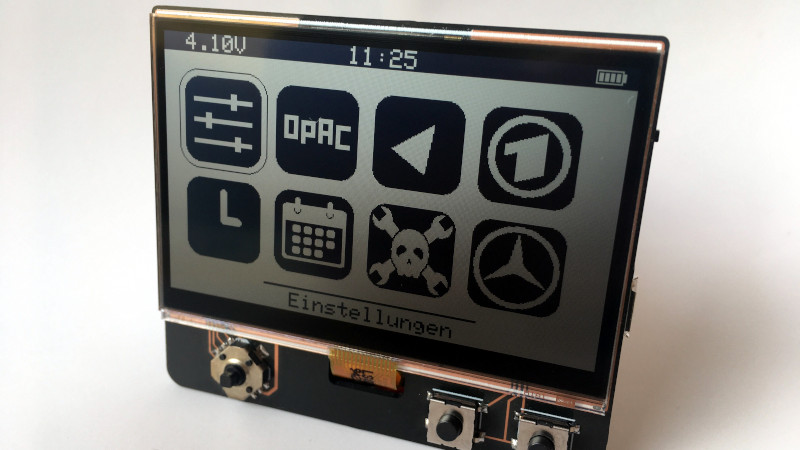Many of us have experimented with the ESP32 microcontroller, attracted by its combination of WiFi and a powerful processor core, but how many of us will have explored all of its many on-board features? One of the more interesting capabilities of this chip comes in the form of its ultra-low-power (ULP) co-processor, an extra core that allows an ESP32 to function while sipping tiny quantities of power with the ever-hungry main cores turned off.
It’s a feature that [Max Kern] has used to great effect in his low power ESP32 handheld computer, where he’s paired the chip with a low-power Sharp Memory LCD and used the ESP32’s ULP core to keep the display alive while the ESP cores are sleeping. Software wise the device sports basic PDA and clock functionality including an RSS parser, all of which can be seen in the video below the break. Its inspiration came from Panic’s crank-equipped Playdate console, with which it shares the Sharp display.
Seeing this device reminds us of some of the badges featuring ESP32 power that we’ve seen over the last few years. An event badge creator has a constant battle to give the device enough battery life to last the distance. It’s a problem the designers of the SHA 2017 badge solved with an e-ink unit, but perhaps the Sharp display could offer a cost-effective alternative for new designs.
















Jenny, you tease! Asking a question and then not giving the answer. But I suppose it does matter a lot what the sleep activity is. In this case 10uA, with 150 uA spikes.
Thanks for this article, am very keen on more like these #esp32 #lowpower
Thank you for the summary! This basically answers the question I had.
Should be interesting to see what people will manage to do with the ESP32-S2, seeing it has a RiscV-based ULP…
Yes, fpga for risc v Will Be Great like fomu
But not replace procesor esp32
Hopefully the rest of the cores will go RiscV in the future. I’m sure Espressif wouldn’t mind getting rid of those Cadence royalties.
When You create a low power consumption device and dont use solar panel.
;)
Sendig trought post a lipo acumulator are very difficult. Meybe You change it to normal recarcable battery AAA?
P.S. If You create a kickstarter campaining and price fall down. I will buy.
I like the tiny d pad :) Nice project of course :)
I’ve been wanting to play with these sharp memory lcds for awhile, but the only ones I could find that were affordable were the tiny ones (and even then at $30+ a pop they are pricier than eink screens of a similar size). The one shown in this project seems to be difficult to find and expensive (I remember seeing one seller on ebay who had a stash of hundreds of them but they were unwilling to sell anything but the lot for a few grand). A few I’ve found that were available in one off quantities were still a good $50 or so. Does anyone have a source for them at a reasonable price or are those my only options.
?!? Found the SHARP LS027B7DH01A for $1880 on AE, shipping included:
https://www.aliexpress.com/item/4000388720940.html
Yikes, that’s some way to miss out a decimal point!
Under $20 I can do, bit worried that the seller has a 0% rating and no feedback (but should be protected if I pay with paypal).
I got it from Digikey for just under 30$:
https://www.digikey.de/product-detail/de/sharp-microelectronics/LS027B7DH01A/425-2908-ND/5054067
Looks to be $31, tempting I’ll add it to my basket for my next order. Thanks!
$30 buys a lot of LiPo capacity. :P Those cheap Chinese 16×2 character LCD consumes around 1mA if you turn off the backlight. I would expect the monochrome “Nokia 5110” would be at similar range.
It’s a bummer Sharp discontinued the LS060S2UD01 memory LCD; It was a 600×800 portrait-mode high contrast memory LCD that supported 1, 2, or 4 bits per pixel grayscale over an 8 or 16 bit command/data style parallel bus. Using it in grayscale mode increased idle power consumption but it was still minimal (it consumed all of 25mW displaying 30fps video after all).
I managed to snag _one_ on clearance and have yet to settle on a project for it…
IM2_TonyStark.gif: “I want one”
srsly the specs look nice on that, not sure why they’d discontinue, unless it cost more than the market would bear. I see some on eBay at $130 a pop, in this day and age that’s not real tempting for the size of screen.
Sharp has 7 monochrome displays (1.08″, 1.26″, 1.28″, 1.8″, 2.7″, 3.2″ and 4.4″). 3.2″ has the highest resolution (336 x 536) and us also the most power hungry (350 uW).
Japan Display has 3 color displays (1.28″, 2.7″ and 4.4″). The 4.4″ is 640 x 480 with 228 uW power consumption, but also much lower refresh rate compared to the Sharp 4.4″.
There’s a low front light option that runs anywhere between 1 – 25 mA based on brightness level needed:
https://www.digikey.com/products/en/optoelectronics/display-modules-lcd-oled-graphic/107?v=2004